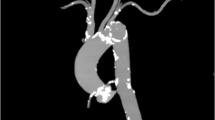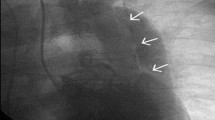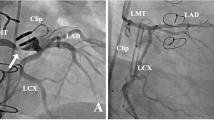Abstract
Background
Significant bradycardia followed by cardiac arrest related to single bolus administration of X-ray contrast medium into a peripheral artery has not, to our knowledge, been described in the literature.
Methods and Results
While performing a percutaneous transluminal angioplasty of the left superficial femoral artery in a 68-year old patient with a pre-existing atrioventricular (AV) block, Wenckebach type, he developed an AV block III after a single bolus injection of intra-arterial X-ray contrast medium.
Conclusion
We believe that application of contrast medium causes a transitory ischemia in the obstructed vessel and therefore elevation of endogenous adenosine. In the case of a previously damaged AV node this elevation of endogenous adenosine may be responsible for the development of a short period of third-degree AV block.

Similar content being viewed by others
References
Donadieu AM, Hartl C, Cardinal A, et al. (1987) Incidence of ventricular fibrillation during coronary arteriography in the rabbit. Invest Radiol 22:106–110
Hesselink JR, Hayman LA, Chung KJ, et al. (1984) Myocardial ischemia during intravenous DSA in patients with cardiac disease. Radiology 153:577–582
Higgins CB, Gerber KH, Mattrey RF, et al. (1982) Evaluation of the hemodynamic effects of intravenous administration of ionic and non-ionic contrast materials. Radiology 142:681–686
Grassi CJ, Bettmann MA, Finkelstein J, et al. (1989) Ioversol double-blind study of a new low osmolar contrast agent for peripheral and visceral arteriography. Invest Radiol 24:133–137
Chilcote WA, Modic MT, Pavlicek WA, et al. (1981) Digital subtraction angiography of the carotid arteries: a comparative study in 100 patients. Radiology 139:287–295
Klow NE, Tande PM, Hevroy O, et al. (1990) Mechanism of ECG changes and arrhythmogenic properties of low osmolality contrast media during coronary arteriography in dog. Cardiovasc Res 24:303–308
Wood GW, Lukin RR, Tomsick TA, et al. (1983) Digital subtraction angiography with intravenous injection: Assessment of 1000 carotid bifurcations. AJR AM J Roentgenol 140: 855–859
Strother CM, Sackett JF, Crummy AB, et al. (1980) Clinical applications of computerised fluoroscopy. Radiology 136:781–783
Keidel WD (1979) Kurzgefasstes Lehrbuch der Physiologie. Thieme, Stuttgart, pp 19.7–19.9
Lerman BB, Belardinelli L (1991) Cardiac electrophysiology of adenosine: Basic and clinical concepts. Circulation 83:1499–1509
Stark U, Stark G (1986) Effects of adenosine on the heart: Therapeutic and diagnostic possibilities. Wien Klin Wochenschr 108:343–351
Stark G, Domanowits H, Sterz F, et al. (1994) Action of ATP on ventricular automaticity. J Cardiovasc Pharmacol 24:740–744
Stark G, Sterz F, Stark U, et al. (1993) Effects of adenosine on electrical activity on isolated guinea pig hearts. Basic Res Cardiol 88:23–32
Hellsten Y, MacLean D, Radegran G, et al. (1998) Adenosine concentrations in the interstitium of resting and contracting human skeletal muscle. Circulation 98:6–8
Author information
Authors and Affiliations
Corresponding author
Rights and permissions
About this article
Cite this article
Brodmann, M., Seinost, G., Stark, G. et al. Aggravation of Pre-Existing Atrioventricular Block, Wenckebach Type, Provoked by Application of X-Ray Contrast Medium. Cardiovasc Intervent Radiol 29, 1114–1116 (2006). https://doi.org/10.1007/s00270-005-0133-x
Published:
Issue Date:
DOI: https://doi.org/10.1007/s00270-005-0133-x




